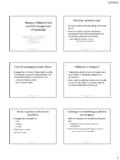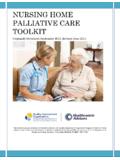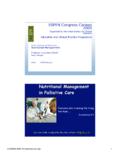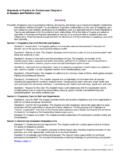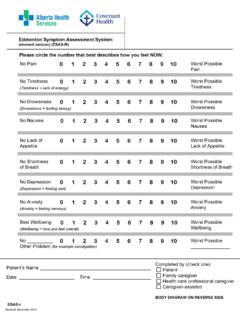Transcription of Symptom Management In Comfort End-Of ... - …
1 Symptom Management In Comfort End-Of -Life Care Of pneumonia Mike Harlos MD, CCFP, FCFP Medical Director, WRHA palliative Care Professor and Section Head, palliative Medicine, Dept. of Family Medicine, University of Manitoba (Pease refer to the Legal Disclaimers on the website: ) ! " # $ % # ! & ! ' & ! ( ! ! & ! ( ! ! ) * + ! , - ! & - ) ' * ! . / ! " # $% %& " ! 01 ! " # $# % An 85 opioid-na ve resident of a personal care home is dying of pneumonia complicating a long history of dementia. She is short of breath, with a respiratory rate of 50/min.
2 She is given morphine 5 mg subcutaneously. 21 % 3 3 $% $% # & # % $% 0'/ 0 " ' ' $ % #$% # ( % ( )4'56- )01 006 # * + ! " " #$.% %& " ' ( " " , ) * , + , $ % , ' , ! # ' ' ' ' !" # $ % & $ '" ! "! #$ ( )! % $ % * + ,!- ." ! ! " # $ "! % % & % ' ( % & % % ) ) ' ( % & ! " # % % & & * % + % % % + $ & & $ % & % & % % % % , - ) % . $ ' ' ' ' ' ' ' ' # , ' ' ) *+ % ) , , !
3 " ! #$ , , % & , #$ + ' ' ! ! " " # $ # % & '( 1. Chen JH, Lamberg JL, Chen YC et al. Occurrence and treatment of suspected pneumonia in long-term care residents dying with advanced dementia. J Am Geriatr Soc 2006; 54: 290-295. 2. Abdel-Karim IA, Sammel RB, Prange MA. Causes of death at autopsy in an inpatient hospice program. J Palliat Med 2007; 10: 894-898. 3. Corcia P, Pradat PF, Salachas F et al. Causes of death in a post-mortem series of ALS patients. Amyotroph Lateral Scler 2008; 9: 59-62. 4. Brandt HE, Ooms ME, Deliens L, van der Wal G, Ribbe MW.)
4 The last two days of life of nursing home patients--a nationwide study on causes of death and burdensome symptoms in The Netherlands. Palliat Med 2006; 20: 533-540. 5. Naz SM, Symmons DP. Mortality in established rheumatoid arthritis. Best Pract Res Clin Rheumatol 2007; 21: 871-883. 6. Jennings AL, Davies AN, Higgins JP, Gibbs JS, Broadley KE. A systematic review of the use of opioids in the Management of dyspnoea. Thorax 2002; 57: 939-944. 7. Sykes N. End of life issues. Eur J Cancer 2008; 44: 1157-1162. 8. Clemens KE, Klaschik E. Morphine in the Management of dyspnoea in ALS.
5 A pilot study. Eur J Neurol 2008; 15: 445-450. 9. Clemens KE, Quednau I, Klaschik E. Is there a higher risk of respiratory depression in opioid-naive palliative care patients during symptomatic therapy of dyspnea with strong opioids? J Palliat Med 2008; 11: 204-216. 10. Azoulay D, Hammerman-Rozenberg R, Cialic R, Ein Mor E, Jacobs JM, Stessman J. Increasing opioid therapy and survival in a hospice. J Am Geriatr Soc 2008; 56(2): 360-361. 11. Partridge JC, Wall SN. Analgesia for dying infants whose life support is withdrawn or withheld. Pediatrics 1997; 99: 76-79. 12. PEARSON JW, DEKORNFELD TJ.
6 Effect of methotrimeprazine on respiration. Anesthesiology 1963; 24: 38-40. 13. Uronis HE, Abernethy AP. Oxygen for relief of dyspnea: what is the evidence? Curr Opin Support Palliat Care 2008; 2: 89-94. 14. Ellershaw JE, Sutcliffe JM, Saunders CM. Dehydration and the dying patient. J Pain Symptom Manage 1995; 10: 192-197. 15. Ahmed S, Sileno AP, deMeireles JC et al. Effects of pH and dose on nasal absorption of scopolamine hydrobromide in human subjects. Pharm Res 2000; 17: 974-977. 16. Klocker N, Hanschke W, Toussaint S, Verse T. Scopolamine nasal spray in motion sickness: a randomised, controlled, and crossover study for the comparison of two scopolamine nasal sprays with oral dimenhydrinate and placebo.
7 Eur J Pharm Sci 2001; 13: 227-232. 17. Fainsinger RL, De Moissac D, Mancini I, Oneschuk D. Sedation for delirium and other symptoms in terminally ill patients in Edmonton. J Palliat Care 2000; 16: 5-10. 18. Bruera E, Miller L, McCallion J, Macmillan K, Krefting L, Hanson J. Cognitive failure in patients with terminal cancer: a prospective study. J Pain Symptom Manage 1992; 7: 192-195. Medications & Initial Dose Guidelines For Comfort End-Of -Life Care Of pneumonia In AdultsMike Harlos MD, CCFP, FCFP Medical Director, WRHA palliative Care Professor and Section Head, palliative Medicine, Dept.
8 Of Family Medicine, Univ. of Manitoba The suggestions below are not intended to be comprehensive advice applicable to all clinical scenarios; suggested medications and doses must be considered in the unique clinical context. The following specific assumptions apply: the prescribing clinician is aware of any medication allergies or intolerances the patient is assumed to be opioid-na ve in the doses suggested below; in a patient already on opioids their existing tolerance will need to be considered. the doses indicated below are conservative starting doses, as there may be some uncertainty about how a medication will be tolerated.
9 These may very well need to be rapidly escalated, as guided by empirical effectiveness, particularly when using opioids to relieve dyspnea or sedatives in agitated delirium. the intramuscular and rectal routes are notwell tolerated and can usually be replaced by subcutaneous or sublingual routes Medication Indications Route Dose Interval Frail elderly and/or mild symptoms Usual adult and moderateto severe symptoms Dyspnea PainEnteral (oral; feeding tube)ORbuccal/sublingual* 5 mg 10 mg q1h prn (if repeated prn doses needed, add a q4h scheduled dose, usually equal to the effective prn dose) Intravenous mg5 10 mg q 15 min.
10 Prn Subcutaneous mg5 10 mg q 30 min prn Morphine Nasal Transmucosal** not recommended; poor bioavailability1 Dyspnea PainEnteral (oral; feeding tube)ORbuccal/sublingual* 1 mg 2 mg q1h prn(if repeated prn doses needed, add a q4h scheduled dose, usually equal to the effective prn dose) Intravenous mg1 2 mg q 15 min.
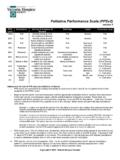
![[P] Clonazepam - Palliative Care](/cache/preview/7/3/1/8/c/1/0/f/thumb-7318c10f561f7c7ba618d52f79801a4d.jpg)

